Obviously, a compressor has a lot of working parts. The good news is that troubleshooting when something’s not quite right is fairly simple if you have a good understanding of the various parts and what they do. Learning about the structure of an air compressor will help you to easily identify them for easy operation and repair; if need be.
Table of Contents
Air Compressor Parts
While it may seem like a lot of work to understand all of the different air compressor parts, learning as much as you can about your new tool will save you time and money in the long run. There are many components that come together to form an air compressor. Some of the common air compressor parts include:
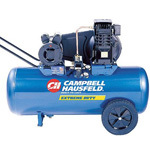 Tank
Tank
his part takes up the majority of the space on the compressor and its function is self-explanatory… to store compressed air. A larger tank is not always better as some tools simply don’t require a 10 gallon tank which takes much longer to fill than a smaller 3 gallon version. On the opposite end, tools that require constant air such as an air sander or grinder should not be run off of a compressor with a small tank. It simply won’t be able to keep up.
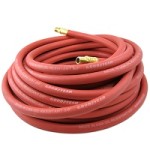 Hose
Hose
The hose leads from the main compressor air tank and goes to the spout that the air exits from. This is a fairly commonly replaced part, especially if the hose came with the compressor. Common issues include tears or rips in the outer lining. There are those who, looking for a quick fix, will simply put some tape over any tears or rips. When you’re dealing with high amounts of air pressure, this simply won’t work well at all. Fortunately, high-quality air hoses are cheap. Here are the air hoses we recommend.
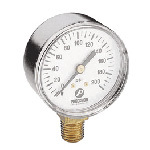 Tank Pressure Gauge
Tank Pressure Gauge
This gauge indicates the pressure of the compressed air that is in the tank. If your gauge shows a pressure reading that is higher than usual, this indicates a problem and immediate action should be taken. If there is a low pressure reading, this means that there is a leak somewhere in the compressor. A tank pressure which remains the same over a period of a few days of non-use indicates a high quality air compressor tank and components.
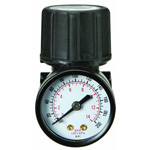 Regulator
Regulator
Different power tools will need varying amounts of air pressure to operate and the pressure can be adjusted with the regulator. This component regulates the amount of pressure in the tank. A typical compressor will have a maximum air pressure range of 125-150 PSI. Without a regulator, your nail gun which requires a pressure of about 70-100 pSI would most likely function incorrectly and even cause damage.
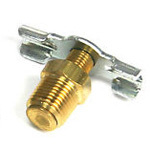 Drain Valve
Drain Valve
This is a very important component because it drains dirt, oil, moisture, and other debris that might get trapped in the tank. For example, condensation forms inside the compressor when it has been used and if this moisture isn’t drained, rust will form inside the tank and cause its structure to weaken. Draining a tank after use is usually one of the easiest things to do as far as maintenance, yet too many people simply don’t do it.
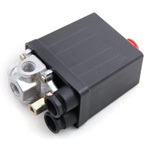 Pressure Switch
Pressure Switch
This component reacts to the changing pressure in the system and will either drop or allow an outgoing signal that is need to initiate an action. In the case of the air compressor, this action is to turn its electric motor on or off. A pressure switch is another part that has a tendency to need replacement over the life of a compressor. This is especially true for some of the lower end brands such as Central Pneumatic, Rockford, and even Campbell Hausfeld.
The Bottom Line
Air compressors are excellent tools that help increase productivity in major ways. By understanding the tool’s major parts, you’ll have an easier time operating and maintaining it. Replacing parts on an air compressor is typically fairly easy and because the most commonly failed parts are usually inexpensive, you’ll save a lot of money on repairs and even avoid the expense of purchasing a new unit.